Factors Affecting Diabetes Mellitus and Care in the Australian Context
VerifiedAdded on 2023/01/04
|8
|2581
|72
Report
AI Summary
This report provides a comprehensive overview of diabetes mellitus in the Australian context. It begins by exploring factors impacting self-esteem in individuals with diabetes, followed by an analysis of issues in diabetes care delivery, considering individual, cultural, and political perspectives. The report then delves into environmental and social factors contributing to diabetes mellitus within the Australian population, with a specific focus on the higher rates among Aboriginal and Torres Strait Islander people. It highlights the significance of the National Diabetes Services Scheme (NDSS) in supporting patients and examines diabetes care within the Australian healthcare system, including the roles of general practitioners, endocrinologists, and the National Association of Diabetes Centres (NADC). The report emphasizes the multifaceted nature of diabetes management and care, offering insights into the challenges and strategies involved in providing effective support to individuals with diabetes in Australia.

HEALTH AND SOCIAL CARE
Paraphrase This Document
Need a fresh take? Get an instant paraphrase of this document with our AI Paraphraser
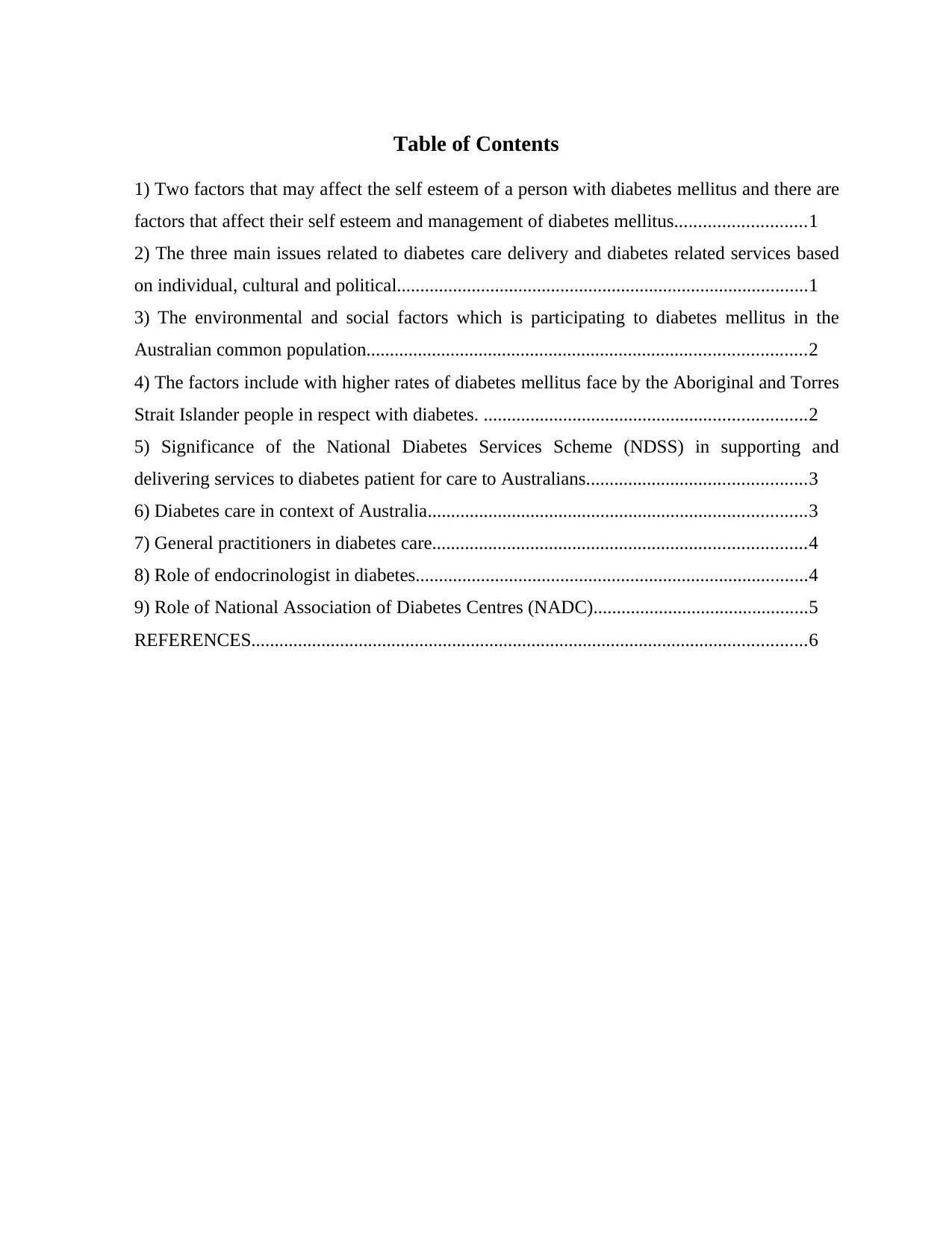
Table of Contents
1) Two factors that may affect the self esteem of a person with diabetes mellitus and there are
factors that affect their self esteem and management of diabetes mellitus............................1
2) The three main issues related to diabetes care delivery and diabetes related services based
on individual, cultural and political........................................................................................1
3) The environmental and social factors which is participating to diabetes mellitus in the
Australian common population..............................................................................................2
4) The factors include with higher rates of diabetes mellitus face by the Aboriginal and Torres
Strait Islander people in respect with diabetes. .....................................................................2
5) Significance of the National Diabetes Services Scheme (NDSS) in supporting and
delivering services to diabetes patient for care to Australians...............................................3
6) Diabetes care in context of Australia.................................................................................3
7) General practitioners in diabetes care................................................................................4
8) Role of endocrinologist in diabetes....................................................................................4
9) Role of National Association of Diabetes Centres (NADC)..............................................5
REFERENCES.......................................................................................................................6
1) Two factors that may affect the self esteem of a person with diabetes mellitus and there are
factors that affect their self esteem and management of diabetes mellitus............................1
2) The three main issues related to diabetes care delivery and diabetes related services based
on individual, cultural and political........................................................................................1
3) The environmental and social factors which is participating to diabetes mellitus in the
Australian common population..............................................................................................2
4) The factors include with higher rates of diabetes mellitus face by the Aboriginal and Torres
Strait Islander people in respect with diabetes. .....................................................................2
5) Significance of the National Diabetes Services Scheme (NDSS) in supporting and
delivering services to diabetes patient for care to Australians...............................................3
6) Diabetes care in context of Australia.................................................................................3
7) General practitioners in diabetes care................................................................................4
8) Role of endocrinologist in diabetes....................................................................................4
9) Role of National Association of Diabetes Centres (NADC)..............................................5
REFERENCES.......................................................................................................................6
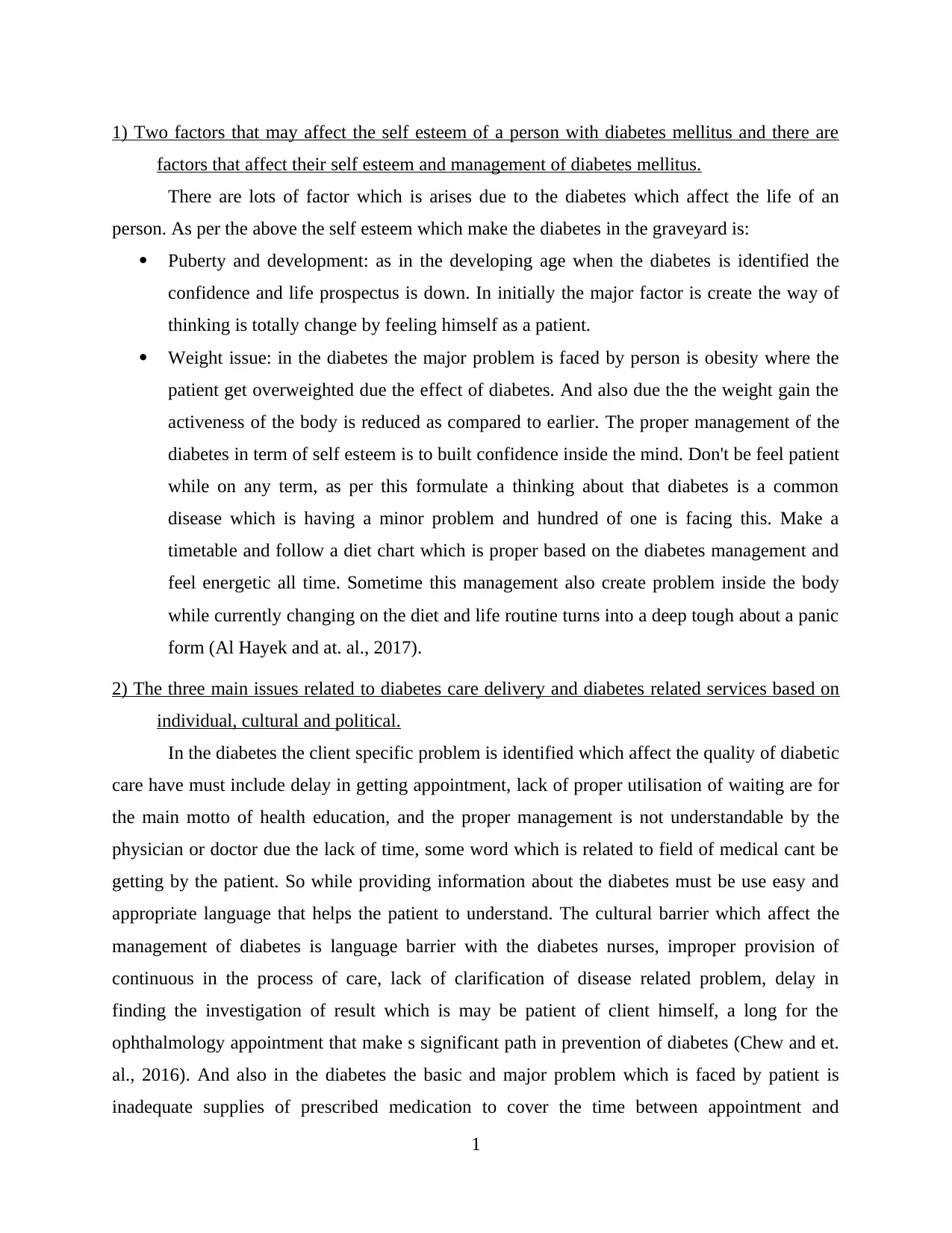
1) Two factors that may affect the self esteem of a person with diabetes mellitus and there are
factors that affect their self esteem and management of diabetes mellitus.
There are lots of factor which is arises due to the diabetes which affect the life of an
person. As per the above the self esteem which make the diabetes in the graveyard is:
Puberty and development: as in the developing age when the diabetes is identified the
confidence and life prospectus is down. In initially the major factor is create the way of
thinking is totally change by feeling himself as a patient.
Weight issue: in the diabetes the major problem is faced by person is obesity where the
patient get overweighted due the effect of diabetes. And also due the the weight gain the
activeness of the body is reduced as compared to earlier. The proper management of the
diabetes in term of self esteem is to built confidence inside the mind. Don't be feel patient
while on any term, as per this formulate a thinking about that diabetes is a common
disease which is having a minor problem and hundred of one is facing this. Make a
timetable and follow a diet chart which is proper based on the diabetes management and
feel energetic all time. Sometime this management also create problem inside the body
while currently changing on the diet and life routine turns into a deep tough about a panic
form (Al Hayek and at. al., 2017).
2) The three main issues related to diabetes care delivery and diabetes related services based on
individual, cultural and political.
In the diabetes the client specific problem is identified which affect the quality of diabetic
care have must include delay in getting appointment, lack of proper utilisation of waiting are for
the main motto of health education, and the proper management is not understandable by the
physician or doctor due the lack of time, some word which is related to field of medical cant be
getting by the patient. So while providing information about the diabetes must be use easy and
appropriate language that helps the patient to understand. The cultural barrier which affect the
management of diabetes is language barrier with the diabetes nurses, improper provision of
continuous in the process of care, lack of clarification of disease related problem, delay in
finding the investigation of result which is may be patient of client himself, a long for the
ophthalmology appointment that make s significant path in prevention of diabetes (Chew and et.
al., 2016). And also in the diabetes the basic and major problem which is faced by patient is
inadequate supplies of prescribed medication to cover the time between appointment and
1
factors that affect their self esteem and management of diabetes mellitus.
There are lots of factor which is arises due to the diabetes which affect the life of an
person. As per the above the self esteem which make the diabetes in the graveyard is:
Puberty and development: as in the developing age when the diabetes is identified the
confidence and life prospectus is down. In initially the major factor is create the way of
thinking is totally change by feeling himself as a patient.
Weight issue: in the diabetes the major problem is faced by person is obesity where the
patient get overweighted due the effect of diabetes. And also due the the weight gain the
activeness of the body is reduced as compared to earlier. The proper management of the
diabetes in term of self esteem is to built confidence inside the mind. Don't be feel patient
while on any term, as per this formulate a thinking about that diabetes is a common
disease which is having a minor problem and hundred of one is facing this. Make a
timetable and follow a diet chart which is proper based on the diabetes management and
feel energetic all time. Sometime this management also create problem inside the body
while currently changing on the diet and life routine turns into a deep tough about a panic
form (Al Hayek and at. al., 2017).
2) The three main issues related to diabetes care delivery and diabetes related services based on
individual, cultural and political.
In the diabetes the client specific problem is identified which affect the quality of diabetic
care have must include delay in getting appointment, lack of proper utilisation of waiting are for
the main motto of health education, and the proper management is not understandable by the
physician or doctor due the lack of time, some word which is related to field of medical cant be
getting by the patient. So while providing information about the diabetes must be use easy and
appropriate language that helps the patient to understand. The cultural barrier which affect the
management of diabetes is language barrier with the diabetes nurses, improper provision of
continuous in the process of care, lack of clarification of disease related problem, delay in
finding the investigation of result which is may be patient of client himself, a long for the
ophthalmology appointment that make s significant path in prevention of diabetes (Chew and et.
al., 2016). And also in the diabetes the basic and major problem which is faced by patient is
inadequate supplies of prescribed medication to cover the time between appointment and
1
⊘ This is a preview!⊘
Do you want full access?
Subscribe today to unlock all pages.

Trusted by 1+ million students worldwide
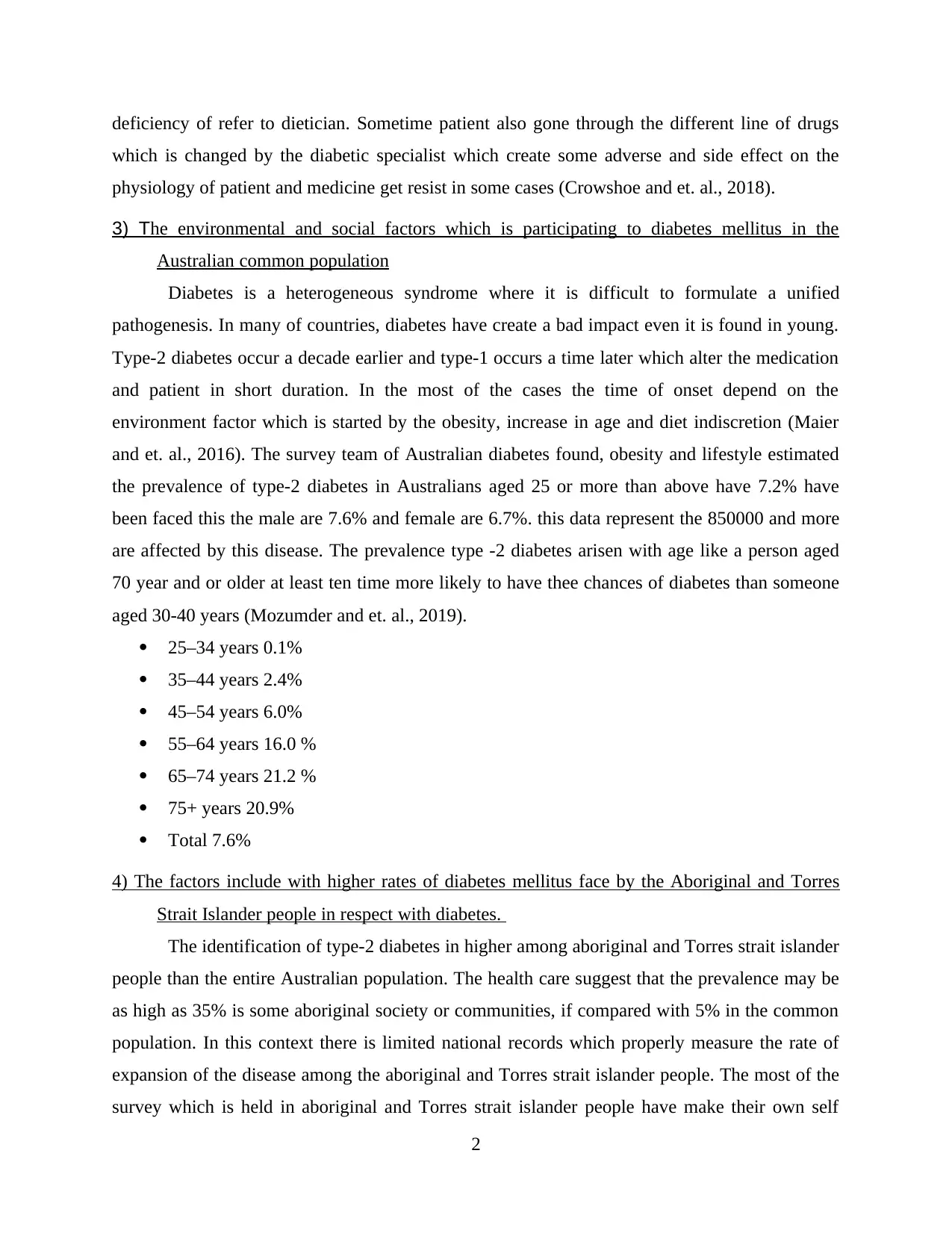
deficiency of refer to dietician. Sometime patient also gone through the different line of drugs
which is changed by the diabetic specialist which create some adverse and side effect on the
physiology of patient and medicine get resist in some cases (Crowshoe and et. al., 2018).
3) The environmental and social factors which is participating to diabetes mellitus in the
Australian common population
Diabetes is a heterogeneous syndrome where it is difficult to formulate a unified
pathogenesis. In many of countries, diabetes have create a bad impact even it is found in young.
Type-2 diabetes occur a decade earlier and type-1 occurs a time later which alter the medication
and patient in short duration. In the most of the cases the time of onset depend on the
environment factor which is started by the obesity, increase in age and diet indiscretion (Maier
and et. al., 2016). The survey team of Australian diabetes found, obesity and lifestyle estimated
the prevalence of type-2 diabetes in Australians aged 25 or more than above have 7.2% have
been faced this the male are 7.6% and female are 6.7%. this data represent the 850000 and more
are affected by this disease. The prevalence type -2 diabetes arisen with age like a person aged
70 year and or older at least ten time more likely to have thee chances of diabetes than someone
aged 30-40 years (Mozumder and et. al., 2019).
25–34 years 0.1%
35–44 years 2.4%
45–54 years 6.0%
55–64 years 16.0 %
65–74 years 21.2 %
75+ years 20.9%
Total 7.6%
4) The factors include with higher rates of diabetes mellitus face by the Aboriginal and Torres
Strait Islander people in respect with diabetes.
The identification of type-2 diabetes in higher among aboriginal and Torres strait islander
people than the entire Australian population. The health care suggest that the prevalence may be
as high as 35% is some aboriginal society or communities, if compared with 5% in the common
population. In this context there is limited national records which properly measure the rate of
expansion of the disease among the aboriginal and Torres strait islander people. The most of the
survey which is held in aboriginal and Torres strait islander people have make their own self
2
which is changed by the diabetic specialist which create some adverse and side effect on the
physiology of patient and medicine get resist in some cases (Crowshoe and et. al., 2018).
3) The environmental and social factors which is participating to diabetes mellitus in the
Australian common population
Diabetes is a heterogeneous syndrome where it is difficult to formulate a unified
pathogenesis. In many of countries, diabetes have create a bad impact even it is found in young.
Type-2 diabetes occur a decade earlier and type-1 occurs a time later which alter the medication
and patient in short duration. In the most of the cases the time of onset depend on the
environment factor which is started by the obesity, increase in age and diet indiscretion (Maier
and et. al., 2016). The survey team of Australian diabetes found, obesity and lifestyle estimated
the prevalence of type-2 diabetes in Australians aged 25 or more than above have 7.2% have
been faced this the male are 7.6% and female are 6.7%. this data represent the 850000 and more
are affected by this disease. The prevalence type -2 diabetes arisen with age like a person aged
70 year and or older at least ten time more likely to have thee chances of diabetes than someone
aged 30-40 years (Mozumder and et. al., 2019).
25–34 years 0.1%
35–44 years 2.4%
45–54 years 6.0%
55–64 years 16.0 %
65–74 years 21.2 %
75+ years 20.9%
Total 7.6%
4) The factors include with higher rates of diabetes mellitus face by the Aboriginal and Torres
Strait Islander people in respect with diabetes.
The identification of type-2 diabetes in higher among aboriginal and Torres strait islander
people than the entire Australian population. The health care suggest that the prevalence may be
as high as 35% is some aboriginal society or communities, if compared with 5% in the common
population. In this context there is limited national records which properly measure the rate of
expansion of the disease among the aboriginal and Torres strait islander people. The most of the
survey which is held in aboriginal and Torres strait islander people have make their own self
2
Paraphrase This Document
Need a fresh take? Get an instant paraphrase of this document with our AI Paraphraser
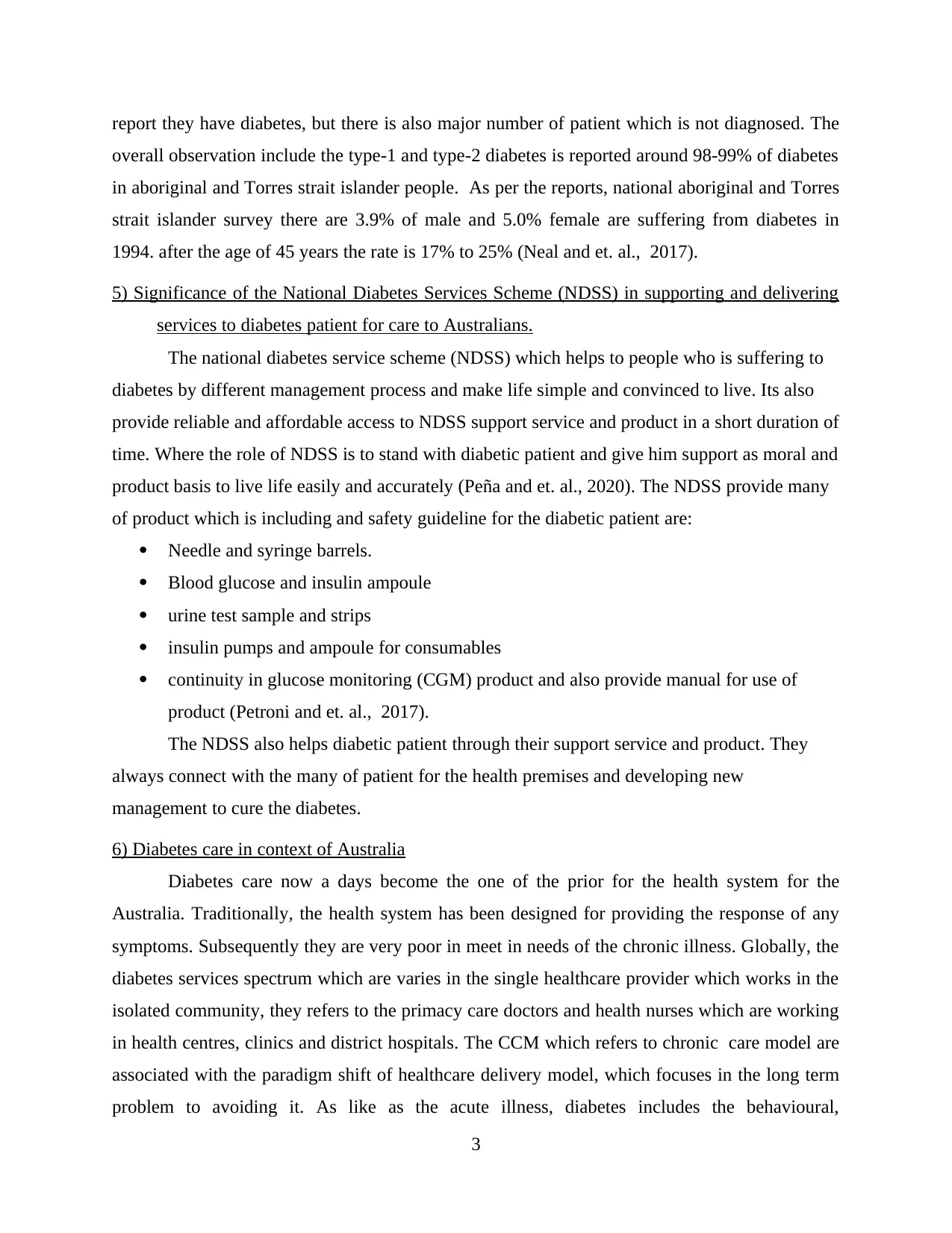
report they have diabetes, but there is also major number of patient which is not diagnosed. The
overall observation include the type-1 and type-2 diabetes is reported around 98-99% of diabetes
in aboriginal and Torres strait islander people. As per the reports, national aboriginal and Torres
strait islander survey there are 3.9% of male and 5.0% female are suffering from diabetes in
1994. after the age of 45 years the rate is 17% to 25% (Neal and et. al., 2017).
5) Significance of the National Diabetes Services Scheme (NDSS) in supporting and delivering
services to diabetes patient for care to Australians.
The national diabetes service scheme (NDSS) which helps to people who is suffering to
diabetes by different management process and make life simple and convinced to live. Its also
provide reliable and affordable access to NDSS support service and product in a short duration of
time. Where the role of NDSS is to stand with diabetic patient and give him support as moral and
product basis to live life easily and accurately (Peña and et. al., 2020). The NDSS provide many
of product which is including and safety guideline for the diabetic patient are:
Needle and syringe barrels.
Blood glucose and insulin ampoule
urine test sample and strips
insulin pumps and ampoule for consumables
continuity in glucose monitoring (CGM) product and also provide manual for use of
product (Petroni and et. al., 2017).
The NDSS also helps diabetic patient through their support service and product. They
always connect with the many of patient for the health premises and developing new
management to cure the diabetes.
6) Diabetes care in context of Australia
Diabetes care now a days become the one of the prior for the health system for the
Australia. Traditionally, the health system has been designed for providing the response of any
symptoms. Subsequently they are very poor in meet in needs of the chronic illness. Globally, the
diabetes services spectrum which are varies in the single healthcare provider which works in the
isolated community, they refers to the primacy care doctors and health nurses which are working
in health centres, clinics and district hospitals. The CCM which refers to chronic care model are
associated with the paradigm shift of healthcare delivery model, which focuses in the long term
problem to avoiding it. As like as the acute illness, diabetes includes the behavioural,
3
overall observation include the type-1 and type-2 diabetes is reported around 98-99% of diabetes
in aboriginal and Torres strait islander people. As per the reports, national aboriginal and Torres
strait islander survey there are 3.9% of male and 5.0% female are suffering from diabetes in
1994. after the age of 45 years the rate is 17% to 25% (Neal and et. al., 2017).
5) Significance of the National Diabetes Services Scheme (NDSS) in supporting and delivering
services to diabetes patient for care to Australians.
The national diabetes service scheme (NDSS) which helps to people who is suffering to
diabetes by different management process and make life simple and convinced to live. Its also
provide reliable and affordable access to NDSS support service and product in a short duration of
time. Where the role of NDSS is to stand with diabetic patient and give him support as moral and
product basis to live life easily and accurately (Peña and et. al., 2020). The NDSS provide many
of product which is including and safety guideline for the diabetic patient are:
Needle and syringe barrels.
Blood glucose and insulin ampoule
urine test sample and strips
insulin pumps and ampoule for consumables
continuity in glucose monitoring (CGM) product and also provide manual for use of
product (Petroni and et. al., 2017).
The NDSS also helps diabetic patient through their support service and product. They
always connect with the many of patient for the health premises and developing new
management to cure the diabetes.
6) Diabetes care in context of Australia
Diabetes care now a days become the one of the prior for the health system for the
Australia. Traditionally, the health system has been designed for providing the response of any
symptoms. Subsequently they are very poor in meet in needs of the chronic illness. Globally, the
diabetes services spectrum which are varies in the single healthcare provider which works in the
isolated community, they refers to the primacy care doctors and health nurses which are working
in health centres, clinics and district hospitals. The CCM which refers to chronic care model are
associated with the paradigm shift of healthcare delivery model, which focuses in the long term
problem to avoiding it. As like as the acute illness, diabetes includes the behavioural,
3
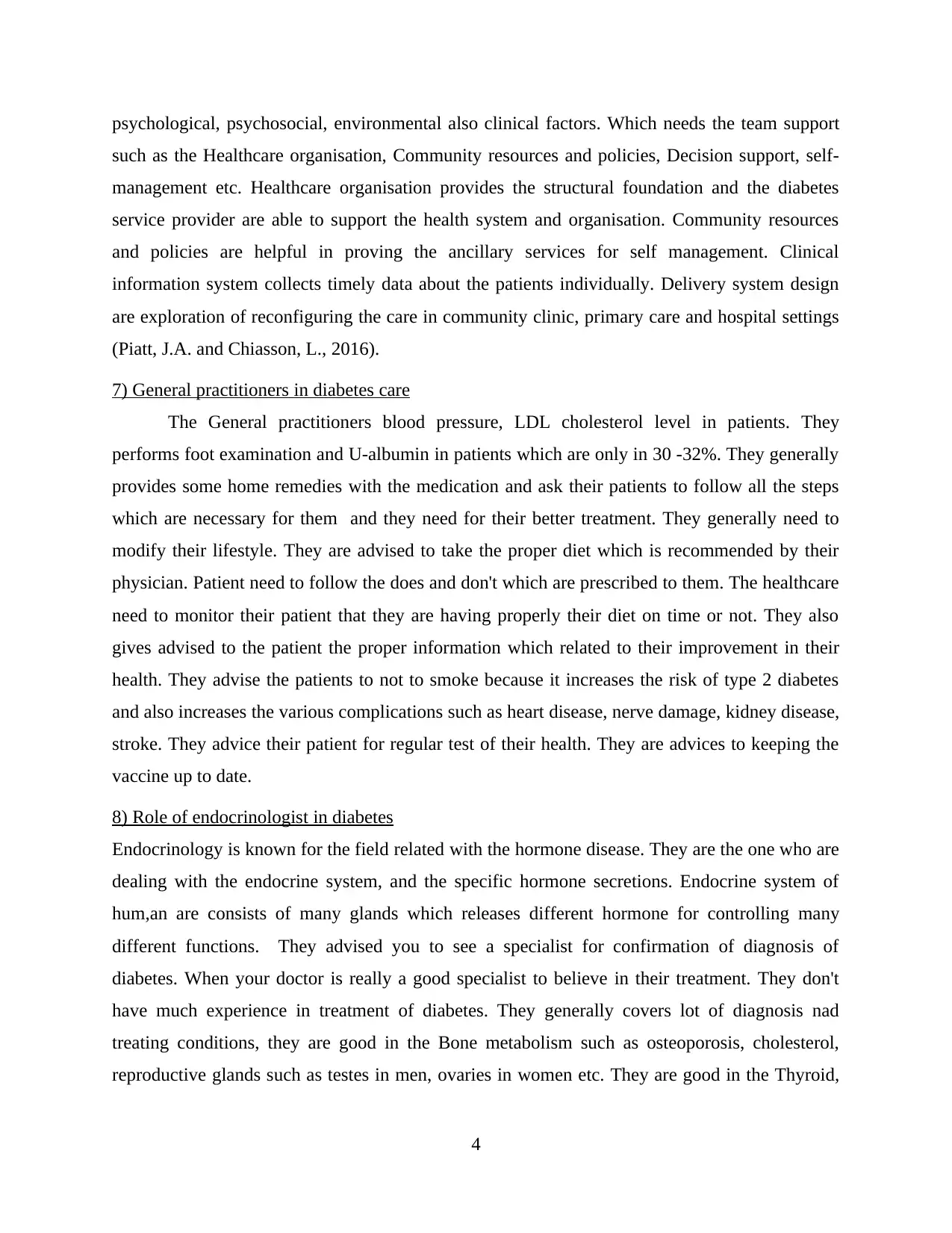
psychological, psychosocial, environmental also clinical factors. Which needs the team support
such as the Healthcare organisation, Community resources and policies, Decision support, self-
management etc. Healthcare organisation provides the structural foundation and the diabetes
service provider are able to support the health system and organisation. Community resources
and policies are helpful in proving the ancillary services for self management. Clinical
information system collects timely data about the patients individually. Delivery system design
are exploration of reconfiguring the care in community clinic, primary care and hospital settings
(Piatt, J.A. and Chiasson, L., 2016).
7) General practitioners in diabetes care
The General practitioners blood pressure, LDL cholesterol level in patients. They
performs foot examination and U-albumin in patients which are only in 30 -32%. They generally
provides some home remedies with the medication and ask their patients to follow all the steps
which are necessary for them and they need for their better treatment. They generally need to
modify their lifestyle. They are advised to take the proper diet which is recommended by their
physician. Patient need to follow the does and don't which are prescribed to them. The healthcare
need to monitor their patient that they are having properly their diet on time or not. They also
gives advised to the patient the proper information which related to their improvement in their
health. They advise the patients to not to smoke because it increases the risk of type 2 diabetes
and also increases the various complications such as heart disease, nerve damage, kidney disease,
stroke. They advice their patient for regular test of their health. They are advices to keeping the
vaccine up to date.
8) Role of endocrinologist in diabetes
Endocrinology is known for the field related with the hormone disease. They are the one who are
dealing with the endocrine system, and the specific hormone secretions. Endocrine system of
hum,an are consists of many glands which releases different hormone for controlling many
different functions. They advised you to see a specialist for confirmation of diagnosis of
diabetes. When your doctor is really a good specialist to believe in their treatment. They don't
have much experience in treatment of diabetes. They generally covers lot of diagnosis nad
treating conditions, they are good in the Bone metabolism such as osteoporosis, cholesterol,
reproductive glands such as testes in men, ovaries in women etc. They are good in the Thyroid,
4
such as the Healthcare organisation, Community resources and policies, Decision support, self-
management etc. Healthcare organisation provides the structural foundation and the diabetes
service provider are able to support the health system and organisation. Community resources
and policies are helpful in proving the ancillary services for self management. Clinical
information system collects timely data about the patients individually. Delivery system design
are exploration of reconfiguring the care in community clinic, primary care and hospital settings
(Piatt, J.A. and Chiasson, L., 2016).
7) General practitioners in diabetes care
The General practitioners blood pressure, LDL cholesterol level in patients. They
performs foot examination and U-albumin in patients which are only in 30 -32%. They generally
provides some home remedies with the medication and ask their patients to follow all the steps
which are necessary for them and they need for their better treatment. They generally need to
modify their lifestyle. They are advised to take the proper diet which is recommended by their
physician. Patient need to follow the does and don't which are prescribed to them. The healthcare
need to monitor their patient that they are having properly their diet on time or not. They also
gives advised to the patient the proper information which related to their improvement in their
health. They advise the patients to not to smoke because it increases the risk of type 2 diabetes
and also increases the various complications such as heart disease, nerve damage, kidney disease,
stroke. They advice their patient for regular test of their health. They are advices to keeping the
vaccine up to date.
8) Role of endocrinologist in diabetes
Endocrinology is known for the field related with the hormone disease. They are the one who are
dealing with the endocrine system, and the specific hormone secretions. Endocrine system of
hum,an are consists of many glands which releases different hormone for controlling many
different functions. They advised you to see a specialist for confirmation of diagnosis of
diabetes. When your doctor is really a good specialist to believe in their treatment. They don't
have much experience in treatment of diabetes. They generally covers lot of diagnosis nad
treating conditions, they are good in the Bone metabolism such as osteoporosis, cholesterol,
reproductive glands such as testes in men, ovaries in women etc. They are good in the Thyroid,
4
⊘ This is a preview!⊘
Do you want full access?
Subscribe today to unlock all pages.

Trusted by 1+ million students worldwide
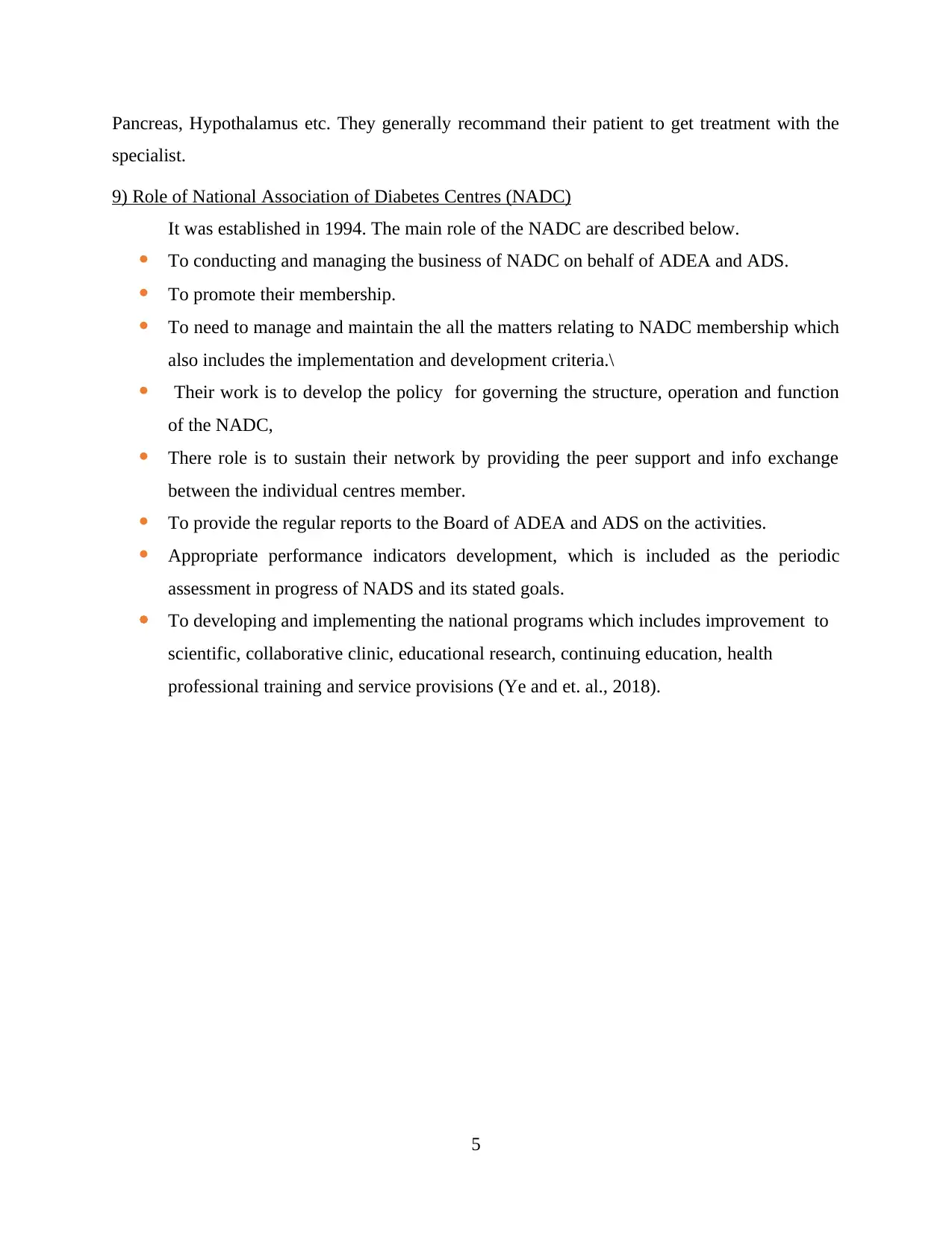
Pancreas, Hypothalamus etc. They generally recommand their patient to get treatment with the
specialist.
9) Role of National Association of Diabetes Centres (NADC)
It was established in 1994. The main role of the NADC are described below.
To conducting and managing the business of NADC on behalf of ADEA and ADS.
To promote their membership.
To need to manage and maintain the all the matters relating to NADC membership which
also includes the implementation and development criteria.\
Their work is to develop the policy for governing the structure, operation and function
of the NADC,
There role is to sustain their network by providing the peer support and info exchange
between the individual centres member.
To provide the regular reports to the Board of ADEA and ADS on the activities.
Appropriate performance indicators development, which is included as the periodic
assessment in progress of NADS and its stated goals.
To developing and implementing the national programs which includes improvement to
scientific, collaborative clinic, educational research, continuing education, health
professional training and service provisions (Ye and et. al., 2018).
5
specialist.
9) Role of National Association of Diabetes Centres (NADC)
It was established in 1994. The main role of the NADC are described below.
To conducting and managing the business of NADC on behalf of ADEA and ADS.
To promote their membership.
To need to manage and maintain the all the matters relating to NADC membership which
also includes the implementation and development criteria.\
Their work is to develop the policy for governing the structure, operation and function
of the NADC,
There role is to sustain their network by providing the peer support and info exchange
between the individual centres member.
To provide the regular reports to the Board of ADEA and ADS on the activities.
Appropriate performance indicators development, which is included as the periodic
assessment in progress of NADS and its stated goals.
To developing and implementing the national programs which includes improvement to
scientific, collaborative clinic, educational research, continuing education, health
professional training and service provisions (Ye and et. al., 2018).
5
Paraphrase This Document
Need a fresh take? Get an instant paraphrase of this document with our AI Paraphraser
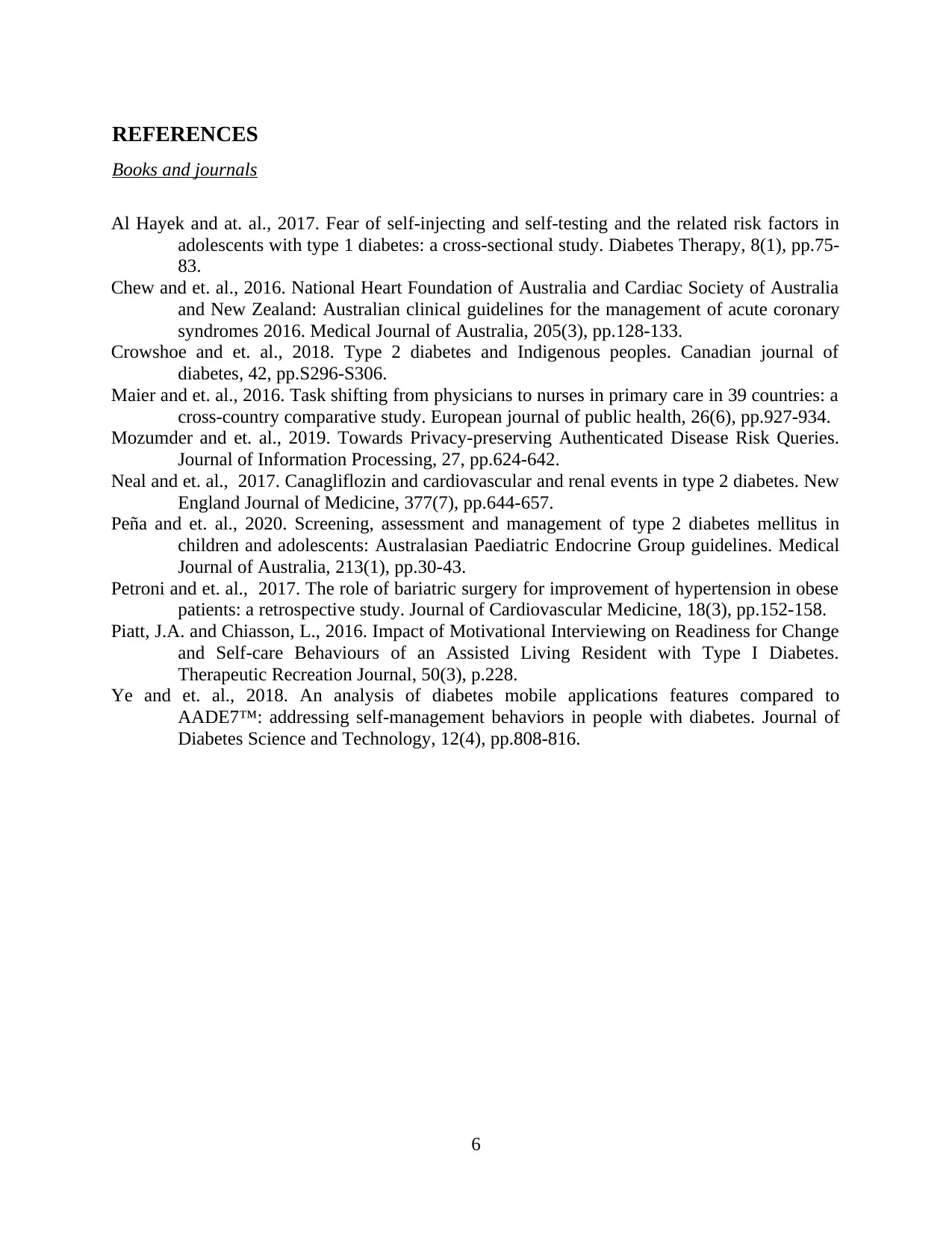
REFERENCES
Books and journals
Al Hayek and at. al., 2017. Fear of self-injecting and self-testing and the related risk factors in
adolescents with type 1 diabetes: a cross-sectional study. Diabetes Therapy, 8(1), pp.75-
83.
Chew and et. al., 2016. National Heart Foundation of Australia and Cardiac Society of Australia
and New Zealand: Australian clinical guidelines for the management of acute coronary
syndromes 2016. Medical Journal of Australia, 205(3), pp.128-133.
Crowshoe and et. al., 2018. Type 2 diabetes and Indigenous peoples. Canadian journal of
diabetes, 42, pp.S296-S306.
Maier and et. al., 2016. Task shifting from physicians to nurses in primary care in 39 countries: a
cross-country comparative study. European journal of public health, 26(6), pp.927-934.
Mozumder and et. al., 2019. Towards Privacy-preserving Authenticated Disease Risk Queries.
Journal of Information Processing, 27, pp.624-642.
Neal and et. al., 2017. Canagliflozin and cardiovascular and renal events in type 2 diabetes. New
England Journal of Medicine, 377(7), pp.644-657.
Peña and et. al., 2020. Screening, assessment and management of type 2 diabetes mellitus in
children and adolescents: Australasian Paediatric Endocrine Group guidelines. Medical
Journal of Australia, 213(1), pp.30-43.
Petroni and et. al., 2017. The role of bariatric surgery for improvement of hypertension in obese
patients: a retrospective study. Journal of Cardiovascular Medicine, 18(3), pp.152-158.
Piatt, J.A. and Chiasson, L., 2016. Impact of Motivational Interviewing on Readiness for Change
and Self-care Behaviours of an Assisted Living Resident with Type I Diabetes.
Therapeutic Recreation Journal, 50(3), p.228.
Ye and et. al., 2018. An analysis of diabetes mobile applications features compared to
AADE7™: addressing self-management behaviors in people with diabetes. Journal of
Diabetes Science and Technology, 12(4), pp.808-816.
6
Books and journals
Al Hayek and at. al., 2017. Fear of self-injecting and self-testing and the related risk factors in
adolescents with type 1 diabetes: a cross-sectional study. Diabetes Therapy, 8(1), pp.75-
83.
Chew and et. al., 2016. National Heart Foundation of Australia and Cardiac Society of Australia
and New Zealand: Australian clinical guidelines for the management of acute coronary
syndromes 2016. Medical Journal of Australia, 205(3), pp.128-133.
Crowshoe and et. al., 2018. Type 2 diabetes and Indigenous peoples. Canadian journal of
diabetes, 42, pp.S296-S306.
Maier and et. al., 2016. Task shifting from physicians to nurses in primary care in 39 countries: a
cross-country comparative study. European journal of public health, 26(6), pp.927-934.
Mozumder and et. al., 2019. Towards Privacy-preserving Authenticated Disease Risk Queries.
Journal of Information Processing, 27, pp.624-642.
Neal and et. al., 2017. Canagliflozin and cardiovascular and renal events in type 2 diabetes. New
England Journal of Medicine, 377(7), pp.644-657.
Peña and et. al., 2020. Screening, assessment and management of type 2 diabetes mellitus in
children and adolescents: Australasian Paediatric Endocrine Group guidelines. Medical
Journal of Australia, 213(1), pp.30-43.
Petroni and et. al., 2017. The role of bariatric surgery for improvement of hypertension in obese
patients: a retrospective study. Journal of Cardiovascular Medicine, 18(3), pp.152-158.
Piatt, J.A. and Chiasson, L., 2016. Impact of Motivational Interviewing on Readiness for Change
and Self-care Behaviours of an Assisted Living Resident with Type I Diabetes.
Therapeutic Recreation Journal, 50(3), p.228.
Ye and et. al., 2018. An analysis of diabetes mobile applications features compared to
AADE7™: addressing self-management behaviors in people with diabetes. Journal of
Diabetes Science and Technology, 12(4), pp.808-816.
6
1 out of 8
Related Documents
Your All-in-One AI-Powered Toolkit for Academic Success.
+13062052269
info@desklib.com
Available 24*7 on WhatsApp / Email
![[object Object]](/_next/static/media/star-bottom.7253800d.svg)
Unlock your academic potential
Copyright © 2020–2025 A2Z Services. All Rights Reserved. Developed and managed by ZUCOL.





